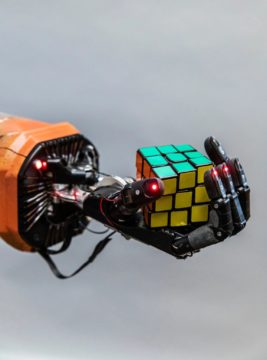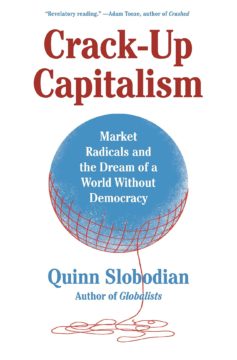My wife looking at the Dolomites from the Villanderer Alm in South Tyrol the day before yesterday.
Month: April 2023
Not Another Lamb
by Eric Bies
 Everyone is talking about artificial intelligence. This is understandable: AI in its current capacity, which we so little understand ourselves, alternately threatens dystopia and promises utopia. We are mostly asking questions. Crucially, we are not asking so much whether the risks outweigh the rewards. That is because the relationship between the first potential and the second is laughably skewed. Most of us are already striving to thrive; whether increasingly superintelligent AI can help us do that is questionable. Whether AI can kill all humans is not.
Everyone is talking about artificial intelligence. This is understandable: AI in its current capacity, which we so little understand ourselves, alternately threatens dystopia and promises utopia. We are mostly asking questions. Crucially, we are not asking so much whether the risks outweigh the rewards. That is because the relationship between the first potential and the second is laughably skewed. Most of us are already striving to thrive; whether increasingly superintelligent AI can help us do that is questionable. Whether AI can kill all humans is not.
So laymen like me potter about and conceive, no longer of Kant’s end-in-itself, but of some increasingly possible end-to-it-all. No surprise, then, when notions of the parallel and the alternate grow more and more conspicuous in our cultural moment. We long for other science-fictional universes.
Happily, then, did the news of the FDA’s approval of one company’s proprietary blend of “cultured chicken cell material” greet my wonky eyes last month.
“Too much time and money has been poured into the research and development of plant-based meat,” I thought. “It’s time we focused our attention on meat-based meat.”
When I shared this milestone with my students—most of them high school freshmen—opinions were split. Like AI, lab-grown meat was quick to take on the Janus-faced contour of promise and threat. The regulatory thumbs-up to GOOD Meat’s synthetic chicken breast was, for some students, evidence of our steady march, aided by science, into a sustainable future. For other students, it was yet another chromium-plated creepy-crawly, an omen of more bad to come. Read more »
The late poet Charles Simic was a chess prodigy
Adrienne Raphel at JSTOR Daily:
 Charles Simic, the late, great Serbian-American poet, was born in 1938 in Belgrade, Yugoslavia. In 1941, when Simic was three, Hitler invaded, and a bomb explosion hurled Simic out of bed. Three years later, in 1944, another series of detonations exploded across town—this time, dropped by Allies. Images of a war-torn country inform Simic’s earliest memories. Belgrade had become a chess board, a deadly battleground for both the Nazis and Allies. Simic emigrated as a boy to the United States, and he wrote poetry in English, but the hellish landscape of his youth lay at the heart of his work.
Charles Simic, the late, great Serbian-American poet, was born in 1938 in Belgrade, Yugoslavia. In 1941, when Simic was three, Hitler invaded, and a bomb explosion hurled Simic out of bed. Three years later, in 1944, another series of detonations exploded across town—this time, dropped by Allies. Images of a war-torn country inform Simic’s earliest memories. Belgrade had become a chess board, a deadly battleground for both the Nazis and Allies. Simic emigrated as a boy to the United States, and he wrote poetry in English, but the hellish landscape of his youth lay at the heart of his work.
Simic was also a chess prodigy, and the game rewired his brain. As he wrote in the New York Review of Books, “The kinds of poems I write—mostly short and requiring endless tinkering—often recall for me games of chess. They depend for their success on word and image being placed in proper order and their endings must have the inevitability and surprise of an elegantly executed checkmate.”
More here.
By imbuing enormous vectors with semantic meaning, we can get machines to reason more abstractly — and efficiently — than before
Anil Ananthaswamy in Quanta:
 The key is that each piece of information, such as the notion of a car, or its make, model or color, or all of it together, is represented as a single entity: a hyperdimensional vector.
The key is that each piece of information, such as the notion of a car, or its make, model or color, or all of it together, is represented as a single entity: a hyperdimensional vector.
A vector is simply an ordered array of numbers. A 3D vector, for example, comprises three numbers: the x, y and z coordinates of a point in 3D space. A hyperdimensional vector, or hypervector, could be an array of 10,000 numbers, say, representing a point in 10,000-dimensional space. These mathematical objects and the algebra to manipulate them are flexible and powerful enough to take modern computing beyond some of its current limitations and foster a new approach to artificial intelligence.
“This is the thing that I’ve been most excited about, practically in my entire career,” Olshausen said. To him and many others, hyperdimensional computing promises a new world in which computing is efficient and robust, and machine-made decisions are entirely transparent.
More here.
Toward a Leisure Ethic
Stuart Whatley in The Hedgehog Review:
 To most people today, the notion of a leisure ethic will sound foreign, paradoxical, and indeed subversive, even though leisure is still commonly associated with the good life. More than any other society in the past, ours certainly has the technology and the wealth to furnish more people with greater freedom over more of their time. Yet because we lack a shared leisure ethic, we have not availed ourselves of that option. Nor does it occur to us even to demand or strive for such a dispensation.
To most people today, the notion of a leisure ethic will sound foreign, paradoxical, and indeed subversive, even though leisure is still commonly associated with the good life. More than any other society in the past, ours certainly has the technology and the wealth to furnish more people with greater freedom over more of their time. Yet because we lack a shared leisure ethic, we have not availed ourselves of that option. Nor does it occur to us even to demand or strive for such a dispensation.
One reason for this is that the values and culture that created our current abundance may be incompatible with actually enjoying it. Sparta had the same problem.
More here.
Researchers Let 25 AI Bots Loose Inside A Virtual Town and The Results Were Fascinating
Victor Tangermann at Futurism:
 The researchers found that their agents could “produce believable individual and emergent social behaviors.” For instance, one agent attempted to throw a Valentine’s Day party by sending out invites and setting a time and place for the party.
The researchers found that their agents could “produce believable individual and emergent social behaviors.” For instance, one agent attempted to throw a Valentine’s Day party by sending out invites and setting a time and place for the party.
A Smallville mayoral race also included the kind of drama you’d expect to occur in a small town.
“To be honest, I don’t like Sam Moore,” an agent called Tom said after being asked what he thought of the mayoral candidate. “I think he’s out of touch with the community and doesn’t have our best interests at heart.”
It got even more human than that.
Vivan Sundaram (1943 – 2023) Visual Artist
https://www.youtube.com/watch?v=kbp6ObL-ilI&ab_channel=NewsX
Kwame Brathwaite (1938 – 2023) Photojournalist
Keith Johnstone (1933 – 2023) Improv Theater Pioneer
Beatle in the Box
Sophie Wright in LensCulture:
 The thought of adding crickets to a summer gazpacho or making your tacos out of honey bee moths is likely to make the majority of us squirm. But faced with a future of growing food scarcity, insects may soon become a kitchen staple; a regular ingredient in our everyday cooking. In Beatle in the box, Italian photographers Michela Benaglia and Emanuela Colombo combine various genres such as still life and food photography in a bid to normalize this fact visually. Rich with proteins, vitamins, carbs, omega-3 fatty acids, calcium, iron and other micronutrients, bugs and beasties have a low environmental-impact as food. They are small, meaning they cause less greenhouse gasses which is an important factor in livestock farming, and they can also be bred easily with few resources. In short, they might be the food of our future. The photographers propose a handy comparison: the growth and spread of sushi through the West in the 1990s—first as a trend, then as a food business.
The thought of adding crickets to a summer gazpacho or making your tacos out of honey bee moths is likely to make the majority of us squirm. But faced with a future of growing food scarcity, insects may soon become a kitchen staple; a regular ingredient in our everyday cooking. In Beatle in the box, Italian photographers Michela Benaglia and Emanuela Colombo combine various genres such as still life and food photography in a bid to normalize this fact visually. Rich with proteins, vitamins, carbs, omega-3 fatty acids, calcium, iron and other micronutrients, bugs and beasties have a low environmental-impact as food. They are small, meaning they cause less greenhouse gasses which is an important factor in livestock farming, and they can also be bred easily with few resources. In short, they might be the food of our future. The photographers propose a handy comparison: the growth and spread of sushi through the West in the 1990s—first as a trend, then as a food business.
In this interview with Sophie Wright for LensCulture, the pair discuss the benefits of eating bugs, the process of insect studio photography and their favorite recipe.
Sophie Wright: How would you describe the key concerns that drive your photography practice? And did Beatle in the box grow out of any existing interests or does it mark a departure from your previous work?
Michela Benaglia & Emanuela Colombo: As documentary photographers we usually work on various current issues that capture our interest and have not yet been explored. Beatle in the box is not an exception: we usually work as reportage photographers, but for this theme the studio photography seemed to us the most effective.
SW: How did your interest in the topic first arise?
MB & EC: We discovered a new law that, starting in 2018, ‘Novel Food’ will enter into force facilitating the sale and the supply of insects within the European Union, bringing all member states on a par with Holland and Belgium where insect-based products have already been for sale in supermarkets for a long time.
More here. (Note: In honor of the first course made up of ants, worms, crickets, scorpions and tiny lobsters my daughter Sheherzad and I enjoyed in Tulum, Mexico, last week)
This Is Too Important to Leave to Microsoft, Google and Facebook
Ezra Klein in The New York Times:
 Among the many unique experiences of reporting on A.I. is this: In a young industry flooded with hype and money, person after person tells me that they are desperate to be regulated, even if it slows them down. In fact, especially if it slows them down. What they tell me is obvious to anyone watching. Competition is forcing them to go too fast and cut too many corners. This technology is too important to be left to a race between Microsoft, Google, Meta and a few other firms. But no one company can slow down to a safe pace without risking irrelevancy. That’s where the government comes in — or so they hope.
Among the many unique experiences of reporting on A.I. is this: In a young industry flooded with hype and money, person after person tells me that they are desperate to be regulated, even if it slows them down. In fact, especially if it slows them down. What they tell me is obvious to anyone watching. Competition is forcing them to go too fast and cut too many corners. This technology is too important to be left to a race between Microsoft, Google, Meta and a few other firms. But no one company can slow down to a safe pace without risking irrelevancy. That’s where the government comes in — or so they hope.
A place to start is with the frameworks policymakers have already put forward to govern A.I. The two major proposals, at least in the West, are the “Blueprint for an A.I. Bill of Rights,” which the White House put forward in 2022, and the Artificial Intelligence Act, which the European Commission proposed in 2021. Then, last week, China released its latest regulatory approach. Let’s start with the European proposal, as it came first. The Artificial Intelligence Act tries to regulate A.I. systems according to how they’re used. It is particularly concerned with high-risk uses, which include everything from overseeing critical infrastructure to grading papers to calculating credit scores to making hiring decisions. High-risk uses, in other words, are any use in which a person’s life or livelihood might depend on a decision made by a machine-learning algorithm.
More here.
Sunday Poem
Exit Strategy
Tell me there is a way to believe it all,
an exit strategy with groggy murmurs
of nothing but rest and a quiet universe.
All I can think of is my child, asleep
in bed, dealing with whatever birthright
his dreams afford his fears, waiting to wake.
Sometimes I feel like Kepler, poised to inherit
pages of wrinkled data, but grumbling,
What a holy-fucking mess Tycho left behind.
Under the surface of the crowd’s rumble
is a song. We could have danced, you know,
to the how-not-why of these perfect heartbeats.
It’s true. You’ve not been asked to understand.
You’ve been asked to listen, and work it out.
George Murray
from: The Rush to Here.
Nightwood Editions, 2007
How Pixies & Doolittle Launched The 90s
‘Veniss Underground’ By Jeff VanderMeer
Noah Berlatsky at the LA Times:
 “They could never believe in a giant fish that holds a whole world. They’d laugh. They’d scoff. Even if they saw it, they wouldn’t believe it. That is why the human race is dying — too limited an imagination.”
“They could never believe in a giant fish that holds a whole world. They’d laugh. They’d scoff. Even if they saw it, they wouldn’t believe it. That is why the human race is dying — too limited an imagination.”
The above quote from Jeff VanderMeer’s first novel, 2003’s “Veniss Underground,” is a kind of statement of purpose for his career. As one of the leading writers of the New Weird, VanderMeer has taken it as his aesthetic and ethical task to push the bounds of the imagination to bizarre, absurd and disgusting extremes.
A new edition of the book, including related stories, fragments and commentary by VanderMeer, shows how consistent his methods and goals have remained over the last 20 years. It also shows, however, that even as he’s grown into a bigger fish, he’s become — admirably and definitively — weirder.
more here.
Fassbinder: Thousands of Mirrors
Anthony Quinn at The Guardian:
 A dream prospect. Rainer Werner Fassbinder, the short-lived, self-destructive wunderkind who made movies about love as masochism, pain as an inevitable condition and history as a dire weight upon his native Germany, has long been in need of an equally forthright celebration. And who better to provide it than one-time NME star, cultural contrarian and film nut Ian Penman, in his first original book since his great comeback suite of music essays, It Gets Me Home, This Curving Track, in 2019? Well, hold your horses.
A dream prospect. Rainer Werner Fassbinder, the short-lived, self-destructive wunderkind who made movies about love as masochism, pain as an inevitable condition and history as a dire weight upon his native Germany, has long been in need of an equally forthright celebration. And who better to provide it than one-time NME star, cultural contrarian and film nut Ian Penman, in his first original book since his great comeback suite of music essays, It Gets Me Home, This Curving Track, in 2019? Well, hold your horses.
Fassbinder – RWF – was an artist whose work once had a “huge and axis-shifting effect” on Penman as a young cinephile. Now, in his early 60s, the fan wonders exactly why he was so enthralled by the film-maker. Straight off, he made the mistake, he says, of trying to rewatch the oeuvre in lockdown: Fassbinder films are about the very last thing you need during an enforced isolation. Berlin Alexanderplatz, his “iconic” TV series, was “especially hard going”. (Funnily enough, I tried the same thing, same time, and had to retire hurt after two episodes.)
more here.
Inside the Black Box

Elham Saeidinezhad in Phenomenal World:
We live in a period of unparalleled financial complexity, and, as the history of recent decades has demonstrated, unparalleled financial risk. The recurring crises which plague the global economy have brought theorists of systemic instability to the fore. Key among them has been Hyman Minsky, whose framework for understanding financial market fragility takes a cyclical form. In his model, an excessive credit expansion (“displacement”) fuels a speculative bubble (“mania” ) and causes “financial distress,” leading to credit contraction and the bursting of the bubble (“panic” ).
The appeal of Minsky’s model lies, in part, in its “structural” perspective. In contrast to the general tendency to disregard financial market practices, Minsky leveraged institutional and legal structures of the financial markets to develop his views. A classic example is his interpretation of the 1980s debt crisis—unlike orthodox theories of profit determination based on productivity and market power, Minsky linked firms’ performance to the developments of the financial market. Specifically, he focused on the 1980s merger and acquisition mania and the structure of junk bonds. Whereas neoclassical theories priced cash flows based on profitability, Minsky analyzed them as claims on firms’ tangible assets, which were often used as collateral for junk bond loans. In the ‘80s, financial distress thus enabled issuers to refrain from making payments, generating a liquidity crisis that neoclassical frameworks could not understand.
More here.
Rise of the Climate Rating Agencies
 Lee Harris in The American Prospect:
Lee Harris in The American Prospect:
In the spring of 2011, heavy rainfall swelled the Mississippi River to record levels, flooding trailer parks and pushing up gas prices as refineries and fuel terminals along the waterway closed. Surveying the wreckage, Heather McTeer Toney, then mayor of Greenville, Mississippi, found a crucial partner in Mars, Inc., the international conglomerate that makes M&M’s and pet food.
Mars operates an 80-acre rice farm in Greenville—its largest factory in the world. The company sent senior officials and shared its in-house risk assessment with Toney, which helped her plan the city’s police and fire response, design street upgrades, identify points of weakness in the wastewater and levee systems, and work with the Army Corps of Engineers.
“Today, we would call that climate risk,” Toney told the Prospect, but at the time it was “just protecting infrastructure.”
Local officials, civil engineers, and homeowners describe a growing need for information on exposure to the risks of extreme weather. In the past five years, demand has exploded. But not all cities have an anchor business as willing to share as Mars, and many might prefer not to depend on private industry for public planning.
Financial markets and private companies, meanwhile, are in an “arms race” for climate intelligence. Some firms have announced decarbonization plans, while others are pledging to double down on fossil fuels. Regulators, struggling to keep up, have asked for more disclosure.
Private climate risk modelers have been the beneficiaries of this gold rush. Their guidance falls into two buckets: physical risk, or material exposure of assets to hazards, or transition risk, which includes fallout from policy changes, impact on the financial system, and reputation.
More here.
Idlers of the World, Unite!
 Charlie Tyson in Jewish Currents:
Charlie Tyson in Jewish Currents:
KARL MARX’S GIFT FOR SATIRE is often underestimated. In his chapter on the working day in Capital, he recounts the death of a 20-year-old dressmaker named Mary Anne Walkley who was “exploited by a lady with the pleasant name of Elise.” After working for 26 1/2 hours straight in a cramped, poorly ventilated room, Walkley suddenly expired, “without, to the astonishment of Madame Elise, having finished off the bit of finery she was working on.” Zola at his most acidic could hardly do better.
Marx peppers the text of Capital with such blackly comic moments. Quoting a factory manager who justifies the 15-hour workday he requires by noting that his machine is always stopped for dinner, Marx comments in a parenthetical: “What generosity!” Describing the adulteration of bread resulting from the capitalist takeover of the baking industry, he reflects: “Englishmen, with their good command of the Bible, knew well enough that man, unless by elective grace a capitalist . . . is destined to eat his bread in the sweat of his brow.” But these pious Brits did not know that their bread would include “cobwebs, dead cockroaches,” and sand, among “other agreeable mineral ingredients.”
If the socialist writer Paul Lafargue, the husband of Marx’s daughter Laura, could not rival his father-in-law’s brilliance or scholarship, he took up the economist’s satirical streak with great enthusiasm, writing humorous sketches, essays, stories, and speeches.
More here.
Feudalism by Design: On Quinn Slobodian’s “Crack-Up Capitalism”
 Jodi Dean in LA Review of Books:
Jodi Dean in LA Review of Books:
AT A RALLY in 2019, California Assembly Speaker Anthony Rendon announced, “When you hear about folks talking about the new economy, the gig economy, the innovation economy, it’s fucking feudalism all over again.” Rendon was there to support legislation classifying most gig workers as employees rather than independent contractors. Assembly Bill 5 was intended to bring gig workers under the protection of existing California labor laws, and the bill passed. But the following year, California voters chose feudalism: they approved Proposition 22, a ballot measure heavily funded by Uber, Lyft, DoorDash, and Instacart, that would exempt app-based drivers from the labor protections that Assembly Bill 5 tried to secure. In March 2023, a state appellate court upheld Prop 22. By making exceptions for the big transportation and delivery apps, by saying that employment laws do not apply to them, California is entrenching the labor relations—the feudalism—that Rendon warned against.
California has long been at the neofeudal vanguard. Sea Ranch, the northern coastal community founded in the 1960s, ushered in the walled settlements and private enclaves that would come to dominate the US housing landscape. California has more private security businesses than any other state (close to double that of Florida, its closest competitor). It also has more charter schools—that is, schools exempted from some state and district laws. California is at the ideological forefront of movements that seek to protect capitalism from democracy, that model communities on corporations, and that idealize the European Middle Ages. While warnings about the unfreedom and deprivation facing a society of servants come at us from all sides, Silicon Valley tech-lords and venture-capitalist libertarians are dreaming up experiments for seceding from, carving up, and perforating nation-states into a neofeudal patchwork of authority and jurisdiction.
More here.
Machine Life
Michael Levin in IAI News:
 One of the most useful metaphors for driving scientific and engineering progress has been that of the “machine.” But in light of our increased understanding of biology, evolution, intelligence, and engineering we must re-examine the life-as-machine metaphor with fair, up-to-date definitions. Such a process is allowing us to see that living things are in fact remarkable, agential, morally-important machines, writes Michael Levin.
One of the most useful metaphors for driving scientific and engineering progress has been that of the “machine.” But in light of our increased understanding of biology, evolution, intelligence, and engineering we must re-examine the life-as-machine metaphor with fair, up-to-date definitions. Such a process is allowing us to see that living things are in fact remarkable, agential, morally-important machines, writes Michael Levin.
The difference between living beings and machines was once apparent. Machines came from a factory and were designed by the real creatives – humans (or in the case of simple machines, such as levers, by crows), who understood exactly how they work. They were boring and predictable – they did the same thing over and over again, they did not adapt to new challenges, and they showed no evidence of having preferences or an inner perspective. Thus, we felt on safe moral ground to do whatever we wanted with them – disassemble them for example. Living beings were the exact opposite in every way. They were created, with great competency but no comprehension, by other living things. On a longer time scale, they appeared as a result of a blind search process (evolution), from an originally abiotic state, becoming infinitely clever in their handling of their environment and of novel challenges and opportunities.
More here.

